Key takeaways
- Voting systems globally vary significantly, influencing political outcomes and public trust in government.
- California’s mail-in voting and early voting options enhance accessibility, though challenges remain for underrepresented communities.
- Communication and clarity around voting processes are crucial for ensuring voter participation and confidence.
- Planning ahead and staying informed about voting options and candidates can improve the voting experience significantly.
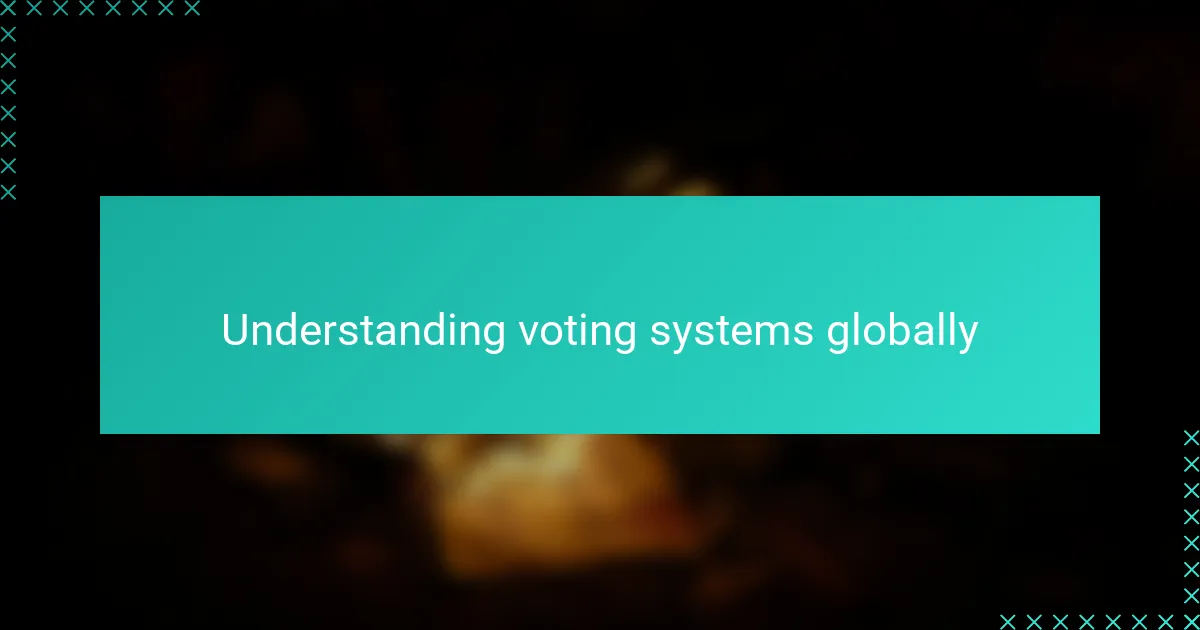
Understanding voting systems globally
Voting systems around the world vary widely, and understanding these differences has made me appreciate the complexity behind each election. For example, some countries use proportional representation, which feels fairer as it mirrors the actual support parties receive, while others stick to a winner-takes-all approach that can leave large groups feeling unheard. Have you ever wondered how these systems shape not just political outcomes but also people’s trust in their governments?
When I first learned about ranked-choice voting, which lets voters rank candidates by preference, I was intrigued by how it encourages more civil campaigns and broader consensus. It made me think about how our own system might benefit from such innovation, reducing polarization and making every vote count more meaningfully. This curiosity about global practices often makes me reflect on how different approaches can influence political engagement and voter satisfaction.
It’s fascinating—and sometimes frustrating—to see how the design of a voting system can either empower or disenfranchise citizens. This realization hit home when I compared California’s system with others that offer online voting or compulsory turnout. What would it feel like to vote in a country where participation is mandatory? Would that change my sense of civic duty or political motivation?
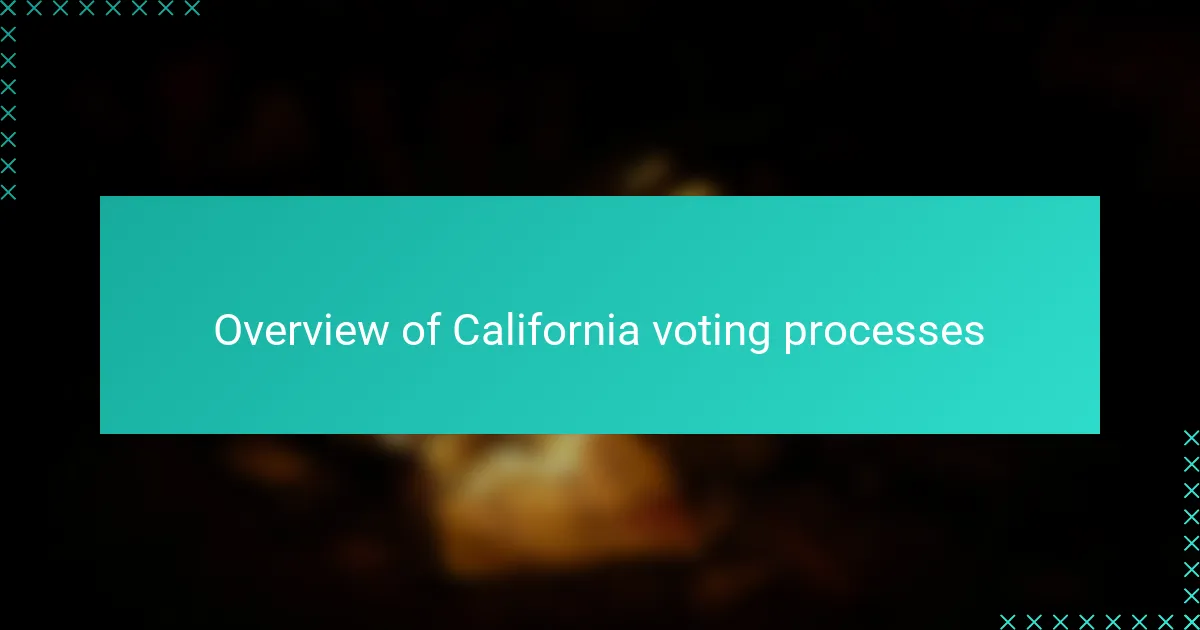
Overview of California voting processes
California’s voting process strikes me as both straightforward and thoughtfully designed, yet it carries its own set of complexities beneath the surface. For instance, the state’s use of mail-in ballots by default impressed me—the convenience felt empowering, especially during busy weeks when getting to a polling place seemed daunting. Have you ever considered how this method might impact voter turnout and accessibility?
What I find particularly interesting is California’s “top-two” primary system, where all candidates compete in a single primary regardless of party, and only the two with the most votes advance to the general election. At first, it felt like a clever way to encourage moderation, but I’ve also wondered if it truly represents the diversity of voter preferences. Does this system foster collaboration or just limit choices in the end?
The availability of early voting and multiple drop-off options adds yet another layer of flexibility that I didn’t expect. From my experience, knowing I could vote early or drop off my ballot at various locations relieved a lot of potential stress, making me feel that the system respects the varied lives of California residents. Still, I ask myself—how accessible are these measures for everyone, especially those with less stable living situations or limited transportation?
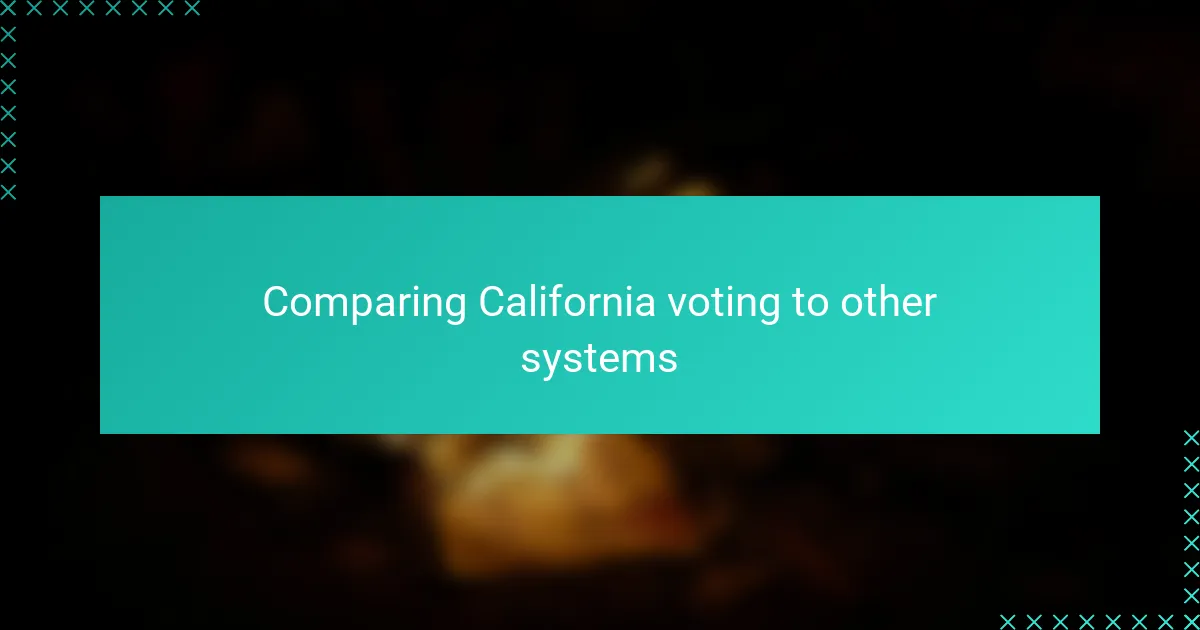
Comparing California voting to other systems
When I first voted in California, the mail-in system felt revolutionary compared to my experiences in other places where you had to physically stand in line at a polling station. That convenience made me wonder—does ease of voting actually motivate more people to participate, or do other barriers still hold some back?
Comparing California’s “top-two” primary to winner-takes-all systems abroad, I sometimes feel torn. While it seems to encourage moderate candidates, I question whether it really captures the full spectrum of political voices or just narrows choices. Have you ever felt that your preferred candidate was edged out too soon because of this format?
In contrast to countries with compulsory voting, California’s voluntary turnout makes each vote feel like an explicit statement of choice—and responsibility. But sometimes I wonder if mandatory participation could boost civic engagement or simply breed resentment. Personally, I appreciate the freedom here, yet I’m curious if that comes at the cost of broader representation.
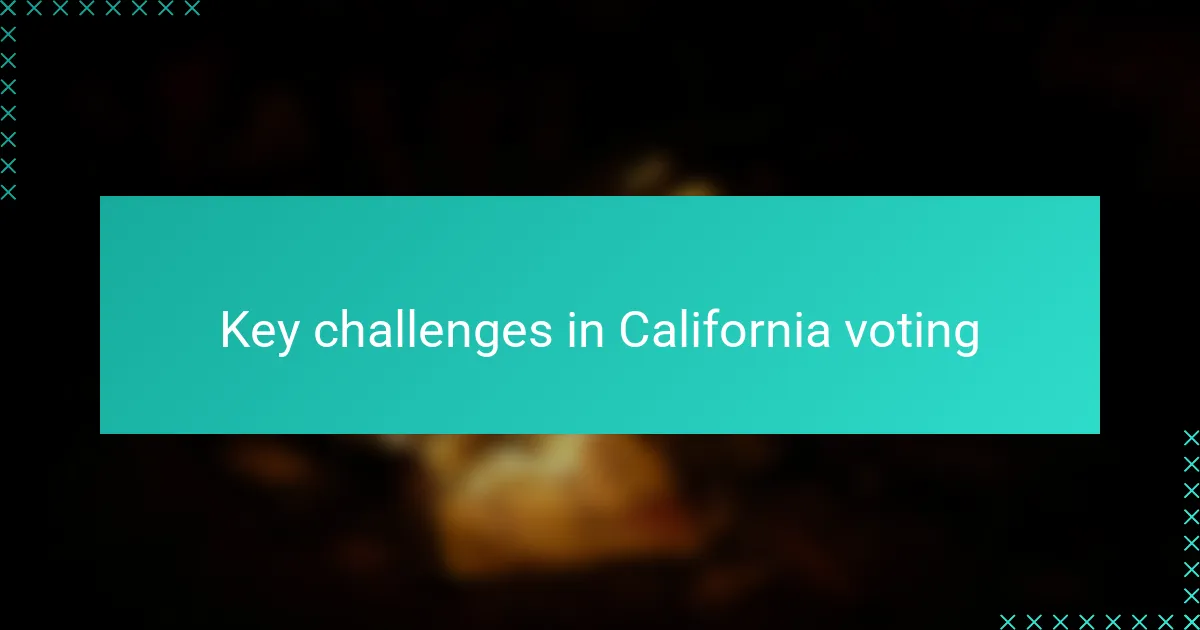
Key challenges in California voting
Sometimes, I found navigating California’s voting system surprisingly confusing, especially when deadlines for mail-in ballots seemed to loom suddenly. It made me question whether clear and consistent communication reaches all voters equally. Have you ever felt unsure if your ballot was counted because of last-minute changes or conflicting information?
Another challenge I encountered relates to voter registration, which, despite being mostly automated, still felt cumbersome for some of my friends who recently moved or changed their names. It highlights a gap that isn’t always obvious until you see someone struggle to update their details in time. Could more streamlined processes help avoid disenfranchisement here?
Accessibility also remains a concern. Although California offers early voting and multiple drop-off points, I’ve noticed that rural areas or communities with limited public transit might still face real hurdles getting their ballots in. This makes me wonder—how can a system be truly fair if physical and logistical barriers quietly exclude certain groups?
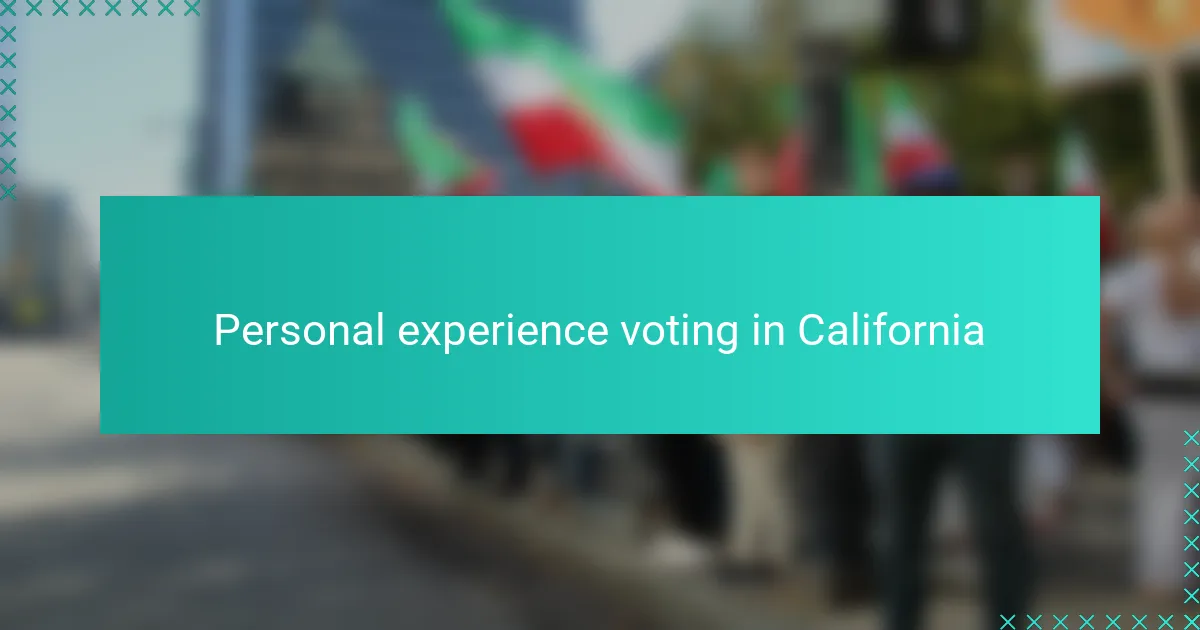
Personal experience voting in California
Voting in California felt surprisingly smooth the first time I mailed in my ballot. I appreciated not having to carve out hours to stand in line, and there was a comforting sense that my vote was counted without hassle. Yet, I remember checking the mailbox anxiously, hoping it arrived on time—does that waiting ever really get easier?
What stood out to me was how many options there are to cast a ballot: mail, early voting, or drop-off centers. That flexibility made me feel that my busy schedule was respected, which isn’t something I had experienced in other states. Still, I have to admit, I sometimes worried whether everyone truly benefits from these conveniences or if some voters fall through the cracks due to travel or unstable living conditions.
One thing I found frustrating was the occasional confusion over deadlines and ballot instructions. Even with reminders, I caught myself double-checking addresses and dates, fearing a simple mistake might invalidate my vote. Have you ever felt that nagging uncertainty, wishing the process were just a little clearer or more reassuring?
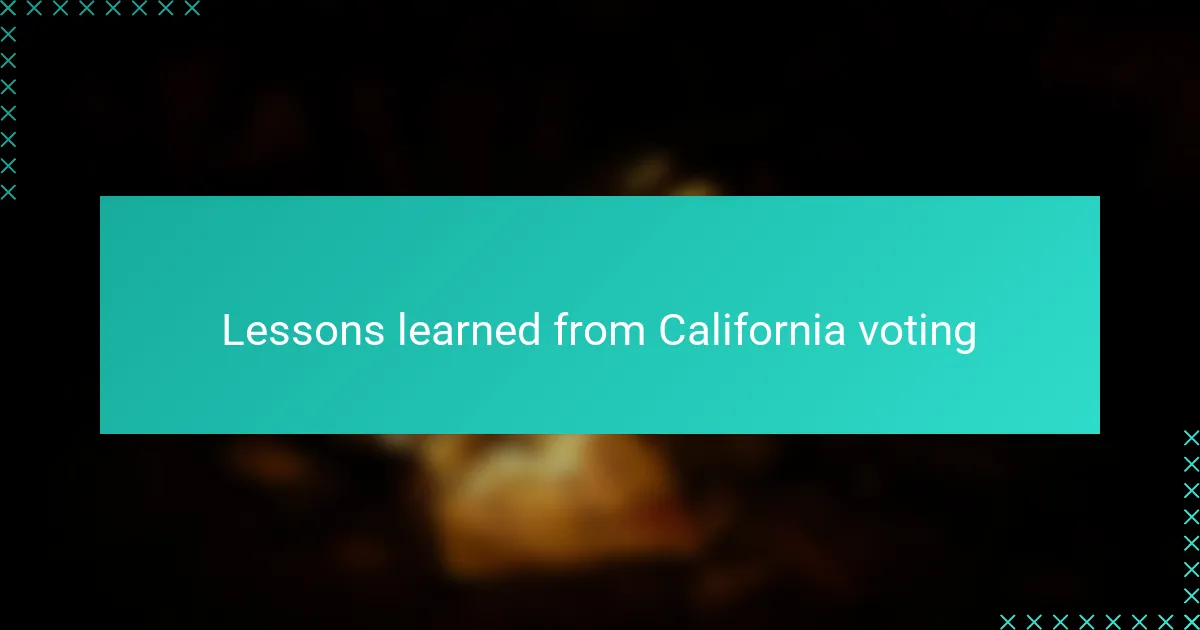
Lessons learned from California voting
One lesson that really stands out to me is the power of convenience in voting. California’s default mail-in ballots removed so many hurdles I expected to encounter, making me realize that when voting is easier, participation can increase. Have you noticed how much calmer and more confident I felt knowing I didn’t have to rush to a polling station on a single day?
Another insight I gained concerns voter education and communication. Even with all the technological advances California has embraced, the occasional confusion around deadlines and procedures made me empathize with people who might just give up out of frustration. Wouldn’t clearer, more consistent messaging help bridge that gap and boost trust in the process?
Finally, California’s system made me reflect on the balance between flexibility and fairness. While early voting and multiple drop-off points sound great in theory, I still wonder if those benefits truly reach everyone equally, especially in less connected communities. How can a system be truly accessible if some voters still struggle with basic logistics? This question lingers with me, shaping how I see election reforms going forward.
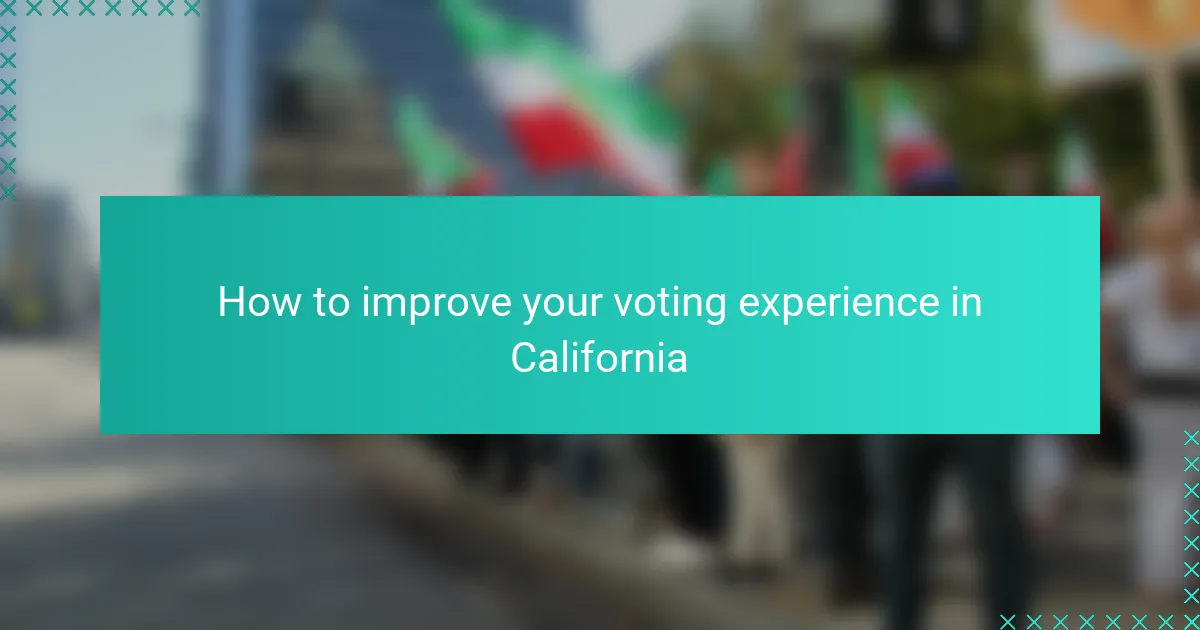
How to improve your voting experience in California
One thing I learned is that planning ahead really improves the voting experience in California. Marking key dates on my calendar and requesting my mail-in ballot early took away last-minute stress. Have you tried setting reminders? From my experience, it makes the whole process smoother and less nerve-wracking.
I also found that familiarizing myself with different voting options paid off. Whether it was dropping off my ballot at a convenient location or voting early in person, having choices helped me fit voting into my busy life. It made me wonder—why not explore all available methods before election day to find what works best for you?
Lastly, I believe staying informed about ballot measures and candidates beforehand changed everything for me. Reading trusted guides and watching candidate forums helped me vote confidently rather than feeling overwhelmed. Isn’t it empowering to know you’re making informed decisions rather than rushing on election day? This approach turned voting into a meaningful part of my civic life.
